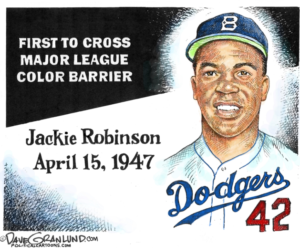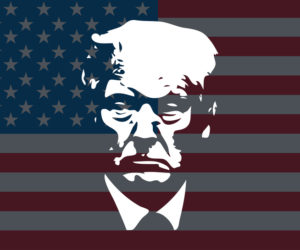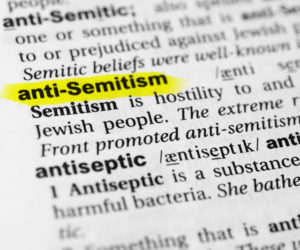When I was a little kid (“little” being ages 10 through 17), I lived in the Netherlands Antilles and in the Netherlands. That was back in the 50s.
I remember Zwarte Piet, or “Black Pete,” well.
I remember them (sometimes there were dozens of them) running and clowning around with their burlap sacks — scaring the daylights out of some little kids, might be a better term — in parades, shopping centers and, as legend had it, coming down the chimney while you were sleeping.
One or more Zwarte Pieten would accompany and help Sinterklaas — named after a 4th-century bishop, Saint Nicholas, the Dutch rendition of our Santa Claus — make his rounds the days before and on Sinterklaas Day, December 5.
That was the day when Dutch kids received most of their Christmas presents, if they had been good, or a lump of coal, or worse — more on this later — if they had been naughty.
I use the past tense because this was sixty years ago and some of the traditions and stories surrounding the Zwarte Pieten may have changed.
But who are these Zwarte Pieten and what do they do?
Sinterklaas arrives on a ship with his Zwarte Pieten at the town of Leidschendam, the Netherlands. (Photo: robert paul van beets / Shutterstock.com)
Again, going back 60 years, Zwarte Pieten were white adolescents with painted black faces (supposedly from the soot picked up scaling down all those chimneys), thick, painted-on, bright-red lips, lots of frizzy black hair, many other “ornaments” such as big gold hoop earrings…and beautiful Dutch blue or green eyes. (No colored contact lenses in those days).
They were Sinterklaas’ knechten (servants) who would help Sinterklaas deliver sweets and gifts to those kids who had behaved throughout the year and would leave only a lump of coal for those children who had not been very nice. Legend and rumor also had it that they would stuff kids who had been naughty and bad into their burlap sacks and haul them back to Spain, or Morocco, or Turkey or wherever current folklore had it that the Zwarte Pieten came from.
Zwarte Piet at a Sinterklaas parade in Scheveningen, Holland.(Photo jan kranendonk / Shutterstock.com)
As I mentioned, I was ten or more in my Sinterklaas days and although somewhat nervous around them I was not really scared.
However, looking back, I can imagine how mortified some of the “naughty” four- or five-year olds must have been around Sinterklaas day.
Also, in those days there were no racial connotations, implications or complaints that I remember about Zwarte Piet.
But back to the present.
A huge controversy has been brewing the last couple of years in the Netherlands surrounding the propriety in today’s society of having these blackface, white minstrel-like Zwarte Pieten still going around enchanting some, scaring others, all in the name of Sinterklaas.
The controversy seems to be raging the most in Amsterdam.
Last year, Amsterdam received 21 official complaints about the traditional Sinterklaas parade citing the racist characteristics of Zwarte Piet and asking the city council to deny a permit for the parade. Amsterdam’s mayor, Eberhard van der Laan, wrote in a letter to the municipal council that while he supports a “less black and less servile” Pete, he deemed the complaints against the parade to be unfounded. But the parade went on.
Last fall, even the United Nations got involved in the controversy when its human rights body allegedly opened up an investigation into whether Zwarte Piet is a “racist stereotype” and “infringes the human rights” of black people.
The Telegraph reported, “It has emerged that the UN’s high commission for human rights has written to the Dutch government expressing concerns over the tradition and accusing the authorities of failing to react to complaints of racial discrimination.”
But a few days later, a UNESCO official assured Holland that “the Dutch tradition of Santa Claus and his blacked-up servant, Black Pete, is safe from United Nations interference,” according to the Telegraph. The UN consultant who had started “all the hoopla” had “abused the name of the UN to bring their own agenda to the media,” Marc Jacobs, a Belgian UNESCO representative told the Algemeen Dagblad newspaper.
Then, last week, an Amsterdam court ruled that Holland’s Zwarte Piet tradition is offensive to black people, perpetuates a negative stereotype of black people and gave the mayor of Amsterdam six weeks to decide whether or not he would hold the city’s annual Sinterklaas parade.
The court said Thursday that Black Pete’s appearance, in combination with the fact that he is often portrayed as dumb and servile, makes it “a negative stereotype of black people.”
.
It also cited a publication by the country’s national human rights commission this week that found that white Dutch leaders frequently react with “irritation and dismissal” when questions of racism are raised, even though workplace discrimination is well documented in the Netherlands.
Many Dutch see this custom as the continuation of a beloved and innocent holiday tradition and point to the historic tolerant nature of the Dutch towards minorities.
This author agrees. However, it is now 2014 — not 1950 — and the Dutch should seriously re-evaluate this tradition before it evolves from inadvertent offensiveness into stubborn and ugly stereotyping of black people.
Lead image: www.shutterstock.com
The author lived and was educated in the Netherlands Antilles and the Netherlands in the 50s and also lived and worked in the Flemish Region of Belgium for five years in the 90s.



















